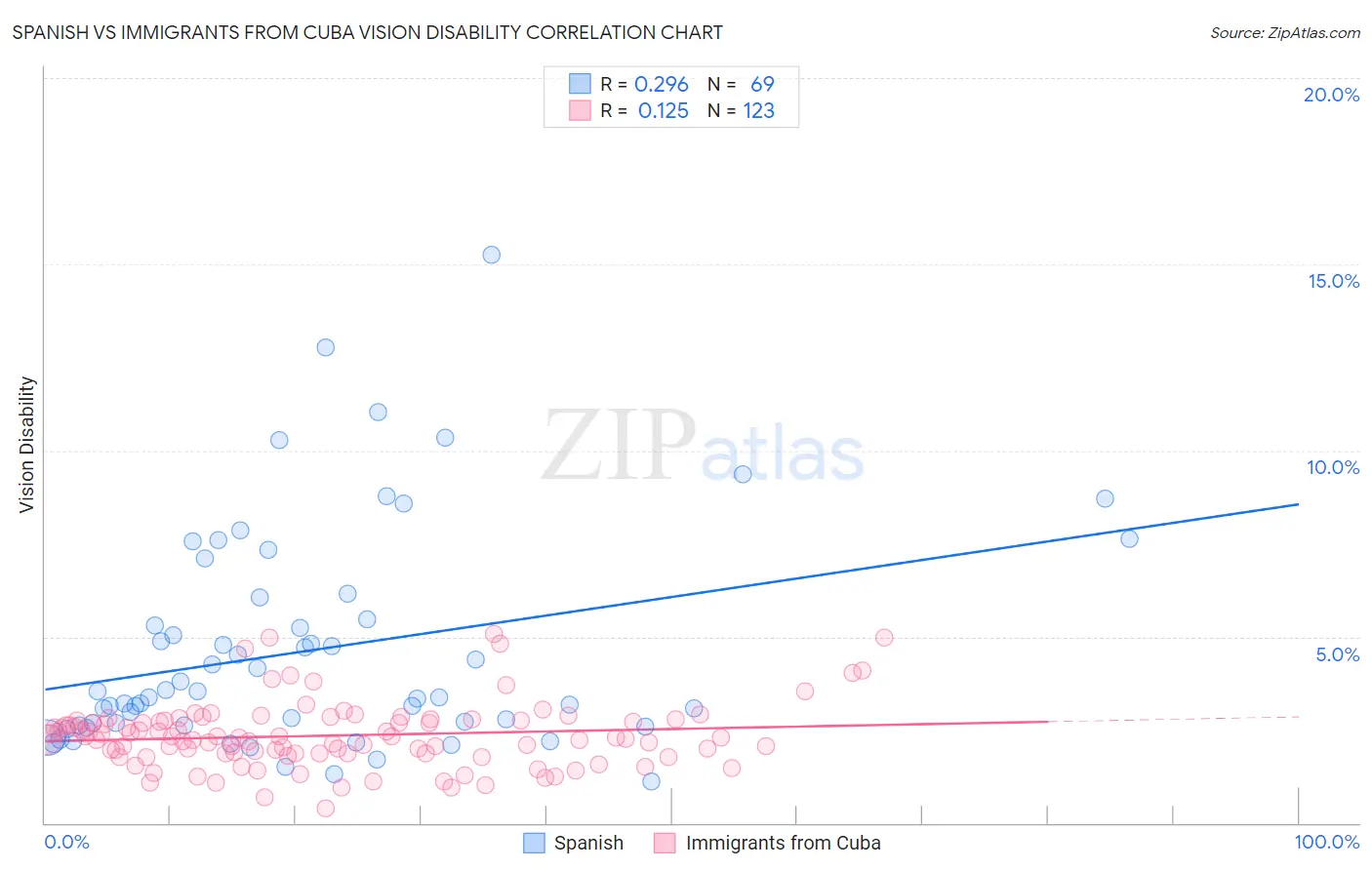Spanish vs Immigrants from Cuba Vision Disability
COMPARE
Spanish
Immigrants from Cuba
Vision Disability
Vision Disability Comparison
Spanish
Immigrants from Cuba
2.4%
VISION DISABILITY
0.0/ 100
METRIC RATING
278th/ 347
METRIC RANK
2.5%
VISION DISABILITY
0.0/ 100
METRIC RATING
290th/ 347
METRIC RANK
Spanish vs Immigrants from Cuba Vision Disability Correlation Chart
The statistical analysis conducted on geographies consisting of 421,761,942 people shows a weak positive correlation between the proportion of Spanish and percentage of population with vision disability in the United States with a correlation coefficient (R) of 0.296 and weighted average of 2.4%. Similarly, the statistical analysis conducted on geographies consisting of 325,877,901 people shows a poor positive correlation between the proportion of Immigrants from Cuba and percentage of population with vision disability in the United States with a correlation coefficient (R) of 0.125 and weighted average of 2.5%, a difference of 1.6%.

Vision Disability Correlation Summary
| Measurement | Spanish | Immigrants from Cuba |
| Minimum | 1.1% | 0.38% |
| Maximum | 15.3% | 5.1% |
| Range | 14.1% | 4.7% |
| Mean | 4.6% | 2.3% |
| Median | 3.4% | 2.3% |
| Interquartile 25% (IQ1) | 2.6% | 1.9% |
| Interquartile 75% (IQ3) | 5.8% | 2.7% |
| Interquartile Range (IQR) | 3.1% | 0.87% |
| Standard Deviation (Sample) | 2.9% | 0.87% |
| Standard Deviation (Population) | 2.9% | 0.87% |
Demographics Similar to Spanish and Immigrants from Cuba by Vision Disability
In terms of vision disability, the demographic groups most similar to Spanish are Nepalese (2.4%, a difference of 0.010%), Cape Verdean (2.4%, a difference of 0.050%), Bahamian (2.4%, a difference of 0.16%), Scotch-Irish (2.4%, a difference of 0.20%), and U.S. Virgin Islander (2.5%, a difference of 0.28%). Similarly, the demographic groups most similar to Immigrants from Cuba are Nonimmigrants (2.5%, a difference of 0.14%), Immigrants from Honduras (2.5%, a difference of 0.39%), Crow (2.5%, a difference of 0.49%), Yaqui (2.5%, a difference of 0.52%), and French American Indian (2.5%, a difference of 0.55%).
| Demographics | Rating | Rank | Vision Disability |
| Immigrants | Latin America | 0.0 /100 | #274 | Tragic 2.4% |
| Chippewa | 0.0 /100 | #275 | Tragic 2.4% |
| Scotch-Irish | 0.0 /100 | #276 | Tragic 2.4% |
| Bahamians | 0.0 /100 | #277 | Tragic 2.4% |
| Spanish | 0.0 /100 | #278 | Tragic 2.4% |
| Nepalese | 0.0 /100 | #279 | Tragic 2.4% |
| Cape Verdeans | 0.0 /100 | #280 | Tragic 2.4% |
| U.S. Virgin Islanders | 0.0 /100 | #281 | Tragic 2.5% |
| Immigrants | Caribbean | 0.0 /100 | #282 | Tragic 2.5% |
| Puget Sound Salish | 0.0 /100 | #283 | Tragic 2.5% |
| Yakama | 0.0 /100 | #284 | Tragic 2.5% |
| Immigrants | Central America | 0.0 /100 | #285 | Tragic 2.5% |
| Sioux | 0.0 /100 | #286 | Tragic 2.5% |
| Hondurans | 0.0 /100 | #287 | Tragic 2.5% |
| French American Indians | 0.0 /100 | #288 | Tragic 2.5% |
| Immigrants | Nonimmigrants | 0.0 /100 | #289 | Tragic 2.5% |
| Immigrants | Cuba | 0.0 /100 | #290 | Tragic 2.5% |
| Immigrants | Honduras | 0.0 /100 | #291 | Tragic 2.5% |
| Crow | 0.0 /100 | #292 | Tragic 2.5% |
| Yaqui | 0.0 /100 | #293 | Tragic 2.5% |
| Ottawa | 0.0 /100 | #294 | Tragic 2.5% |